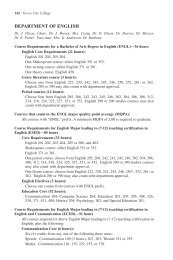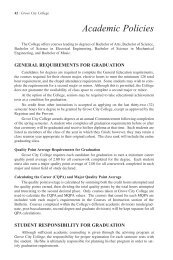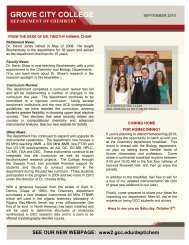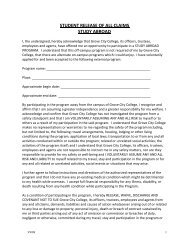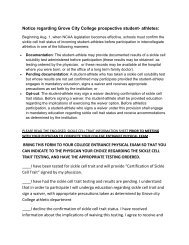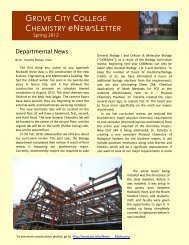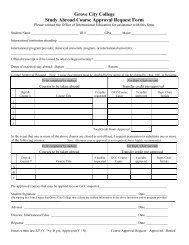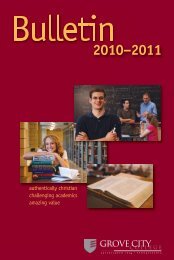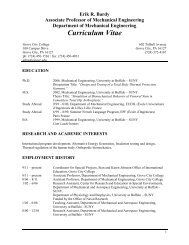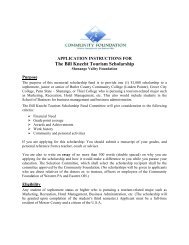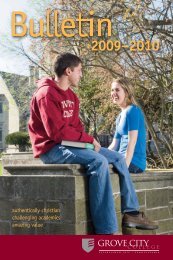A Review of Power-Generating Turbomachines - Grove City College
A Review of Power-Generating Turbomachines - Grove City College
A Review of Power-Generating Turbomachines - Grove City College
Create successful ePaper yourself
Turn your PDF publications into a flip-book with our unique Google optimized e-Paper software.
have made their greatest impact, is their application to aircraft propulsion. In aircraft gas<br />
turbines, which are designed for efficiency as well as diameter and weight, a more sophisticated<br />
design includes the following components: compressor (centrifugal or axial), fans, combustors,<br />
turbine (radial or axial), ducts, air systems, nozzle guide vanes (NGVs), mixers, afterburners, and<br />
heat exchangers. 9 Typical configurations include shaft-powered (turboprops and turboshafts,<br />
used for fixed-wing and rotary-wing aircraft, respectively) and thrust-propelled (turbojets,<br />
turb<strong>of</strong>ans, and ramjets). Typical gas turbine design is similar to that <strong>of</strong> a steam turbine, with one<br />
stage being comprised <strong>of</strong> a row <strong>of</strong> nozzle guide vanes, and a corresponding row <strong>of</strong> rotor blades<br />
mounted on a rotor disc connected to the main shaft.<br />
2.3 Future Developments and Research<br />
Aside from improving efficiency, critical areas <strong>of</strong> research are fuel availability, fuel flexibility,<br />
and emissions reduction. There is presently significant research being done on combustion<br />
characteristics <strong>of</strong> alternative fuels such as ethanol 10 , palm methyl ester (PME) 11 , dimethyl ester<br />
(DME) 12 , hydrogen/syngas 13,14 , and bi<strong>of</strong>uels. 15 Researchers are using 3D CFD codes to simulate<br />
alternative fuel combustion flows and flame propagation within turbines and to analyze the fluid<br />
dynamic effects. 13,16<br />
In addition to fuel research, researchers are turning<br />
their attention more and more to emissions<br />
reduction as tighter governmental regulations<br />
necessitate. 17 As turbine efficiency has increased<br />
with increasing turbine inlet temperatures, so too<br />
has NOx production which tends to increase with<br />
inlet temperature. New engine and combustor<br />
configurations are being investigated to address<br />
these effects.<br />
Another key advancement to the future <strong>of</strong> turbine<br />
technology is turbine cooling <strong>of</strong> components in gas<br />
turbine engines to achieve higher turbine inlet<br />
temperatures. 1 Increased inlet temperatures lead to<br />
better performance and lifespan <strong>of</strong> the turbine. The thermodynamic ideal inlet temperature is<br />
around 2000 °C, but even the most advanced metal alloys cannot operate above 980 °C; hence<br />
the need for advanced cooling systems. Multiple-use alternative jet fuels are being researched<br />
and developed to achieve the desired combustion efficiency, combustion stability, emission<br />
levels, and even cooling properties. 18<br />
Figure 3: Axial turbine configuration. 9<br />
3.0 Hydroelectric/Hydraulic Turbines<br />
3.1 Past<br />
Energy has been extracted from flowing rivers and waterfalls for centuries, typically in the form<br />
<strong>of</strong> rotating waterwheels. Today hydroelectric power stations use reservoirs to control and direct<br />
flow over massive hydraulic turbines to produce electrical power on a grand scale. Very large<br />
unit sizes exceeding 800 MW in capacity have been attained, along with efficiencies upwards <strong>of</strong><br />
95%. 19 In 2007 approximately 36% <strong>of</strong> all renewable energy generated in the US came from<br />
Proceedings <strong>of</strong> the 2012 ASEE North Central Section Conference<br />
Copyright © 2012, American Society for Engineering Education<br />
4



